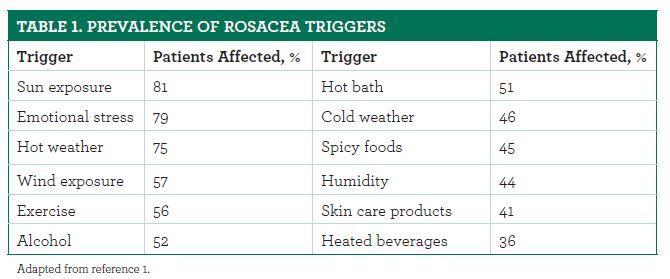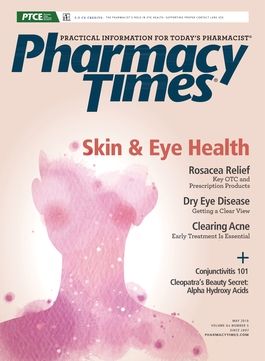Publication
Article
Pharmacy Times
Relieving Rosacea's Redness: Key OTC and Prescription Products
From 6 million to 32 million Americans, or 5% to 10% of adults, have rosacea, but just a small fraction of those affected are being treated.
From 6 million to 32 million Americans, or 5% to 10% of adults, have rosacea, but just a small fraction of those affected are being treated. Most common in fair-skinned individuals, rosacea tends to cluster in northern latitudes, often runs in families, and usually starts during an individual’s 30s. Its sudden onset and similarity to acne, seborrheic dermatitis, and sun damage complicates diagnosis.1,2

Rosacea begins with a tendency to blush or flush easily. Redness can spread beyond the cheeks and nose to the back, chest, and ears, and the skin usually is very sensitive. The condition involves more than redness, however—it occurs in 4 subtypes (see Figure), though many patients have 2 or more types.3
- Erythematotelangiectatic rosacea is distinguished by flushing, redness, and visible blood vessels. Central flushing and redness are prominent, and skin may appear swollen or burn and sting. Dryness, roughness, or scaling also may occur.3 Diffuse vascular erythema (flushing) is rosacea’s most common symptom.4
- Papulopustular rosacea manifests as redness, swelling, and acnelike breakouts that may come and go, usually developing where the skin is most reddened. Burning, sensitive, or stinging skin with visibly broken blood vessels is the hallmark. Plaques or raised patches also may appear on the face.3
- The rare phymatous subtype—sebaceous gland hypertrophy—usually develops after another rosacea subtype. Skin thickening occurs most often on the nose (sometimes called rum or whiskey nose, though alcohol is not a factor) but can also affect the cheeks, chin, ears, and forehead.3
- Ocular rosacea causes red, irritated eyes with swollen lids that can resemble sty formation. Eyes may be bloodshot or watery and feel dry and gritty. Blurry vision and light sensitivity may occur.3
Chronic and progressive in a waxing-and-waning fashion, rosacea can create self-esteem issues and social anxiety.5 Patients worry that the condition will worsen or cause irreversible disfigurement.3 More than 74% of patients with rosacea report fielding intrusive comments or questions, and 87% believe that people judge them negatively by their appearance.6 Patients may avoid social situations and have difficulty establishing new relationships.2,6 In addition, 66% of patients with severe symptoms said that rosacea compromised their professional interactions.7
Symptom Triggers
Outside factors often exacerbate rosacea symptoms (Table 1). Flare-ups also may be associated with certain foods and cosmetics.8

About 82% of individuals with rosacea are untreated, even though treatment can make a tremendous difference.9,10 Nearly 70% of patients who have received treatment report improved social and work lives after effective therapy.6,7 Treatment goals include:1
- Alleviating erythema, papules, pustules, and skin irritation
- Delaying or preventing progression from mild to more severe stages
- Avoiding exacerbations and facilitating remission
- Improving quality of life
- Maintaining optimum skin condition
Treatment of each subtype differs. Topical agents are first-line therapy in mild to moderate rosacea. The FDA has approved 6 topicals for rosacea (Table 2). Many patients respond just incompletely to topical agents. Others experience distressing flare-ups that require stepped-up treatment. If topical treatment is insufficient after 8 to 12 weeks, patients may need to add oral doxyclycline or minocycline (not for their anti-infective properties but for their anti-inflammatory properties) or low-dose ivermectin.3

About one-third of patients with rosacea use metronidazole. Pharmacists should note that most individuals with rosacea use nothing at all for the condition or are notoriously nonadherent, probably because they consider their treatments ineffective. Explaining how to use topicals reduces adverse effects and improves compliance and use. About 80% of patients will need to use more than 1 therapy concurrently or sequentially. Up to one-third of patients need 3 or more prescription medications.11,12
At the Pharmacy
Pharmacists should monitor concurrent medications carefully. Calcium channel blockers may enhance or induce symptoms, and some antihypertensives may reduce symptoms and are sometimes used off-label to treat rosacea. Anecdotal evidence indicates that beta-blockers, clonidine, naloxone, ondansetron, and selective serotonin reuptake inhibitors may reduce flushing. A number of other drugs cause flushing and may exacerbate rosacea.4 Counsel patients to avoid benzoyl peroxide, glycolic acid, propylene glycol, and topical retinoids.13,14
Rosacea patients use a large assortment of nonprescription skin care products, including mild cleansers, moisturizers, and sunscreens. Sunscreen is a critical component of skin care because sun exposure triggers rosacea flare-ups. Patients with erythematotelangiectatic and papulopustular rosacea should look for mild OTC cleansers and moisturizers to self-treat burning, dryness, itching, stinging, and tightness.15 Recommend products that contain just cetyl alcohol, glycerol monostearate, mineral oil, petrolatum, preservative, stearic acid, thickeners, and water. Recommend non—soap-based surfactants and synthetic detergents with low to neutral pH. 13,16
Conclusion
Individuals who experience rosacea tend to use prescription products just to treat flare-ups and rely on OTC products for long-term control. Millions of patients would benefit from prescription drug treatment. Management strategies must be tailored to specific symptoms, and often, periods of trial and error are needed. Clinicians also must consider rosacea’s psychological and psychosocial impact and suggest stepping up treatment when flare-ups occur.
Jeannette Y. Wick, RPh, MBA, FASCP, is assistant director of the Office of Pharmacy Professional Development at the University of Connecticut School of Pharmacy in Storrs.
References
- Oge LK, Muncie HL, Phillips-Savoy AR. Rosacea: diagnosis and treatment. Am Fam Physician. 2015;92(3):187-96.
- If you have rosacea, you’re not alone. National Rosacea Society website. rosacea.org/patients/index.php. Accessed March 27, 2018.
- Rosacea: overview. American Academy of Dermatology website. aad.org/public/diseases/acne-and-rosacea/rosacea#overview. Accessed March 27, 2018.
- Steinhoff M, Schmelz M, Schauber J. Facial erythema of rosacea - aetiology, different pathophysiologies and treatment options. Acta Derm Venereol. 2016;96(5):579-86. doi: 10.2340/00015555-2335.
- Johnston SA, Krasuska M, Millings A, Lavda AC, Thompson AR. Experiences of rosacea and its treatment: an interpretative phenomenological analysis. Br J Dermatol. 2018;178(1):154-160. doi: 10.1111/bjd.15780.
- Rosacea often affects patients’ social lives, new survey finds. Rosacea Review. Summer 2005. rosacea.org/rr/2005/summer/article_3.php. Accessed March 27, 2018.
- Survey shows rosacea disrupts work for patients with severe symptoms. Rosacea Review. Fall 2000. rosacea.org/rr/2000/fall/article_3.php. Accessed March 27, 2018.
- New survey pinpoints leading factors that trigger symptoms. Rosacea Review. Summer 2002. rosacea.org/rr/2002/summer/article_3.php. Accessed March 27, 2018.
- Krasuska M, Millings A, Lavda, Thompson A. Psychological needs and availability of support for people with rosacea and psoriasis: findings from a GP survey. Dermatol Nurs. 2016;15(2):48-49.
- Wehausen B, Hill DE, Feldman SR. Most people with psoriasis or rosacea are not being treated: a large population study. Dermatol Online J. 2016;22(7).
- Egeberg A. Evidence-based management of rosacea. Br J Dermatol. 2017;176(2):300-301. doi: 10.1111/bjd.15277.
- Rosacea.org - survey. National Rosea Society website. rosacea.org/taxonomy/term/106/feed. Accessed March 27, 2018.
- Draelos ZD. Cosmeceuticals for rosacea. Clin Dermatol. 2017;35(2):213-217. doi: 10.1016/j.clindermatol.2016.10.017.
- Jappe U, Schäfer T, Schnuch A, Uter W. Contact allergy in patients with rosacea: a clinic-based, prospective epidemiological study. J Eur Acad Dermatol Venereol. 2008;22(10):1208-1214. doi: 10.1111/j.1468-3083.2008.02778.x.
- Alinia H, Lan L, Kuo S, Huang KE, Taylor SL, Feldman SR. Rosacea patient perspectives on homeopathic and over-the-counter therapies. J Clin Aesthet Dermatol. 2015;8(10):30-4.
- Subramanyan K. Role of mild cleansing in the management of patient skin. Dermatol Ther. 2004;17(suppl 1):26-34.







